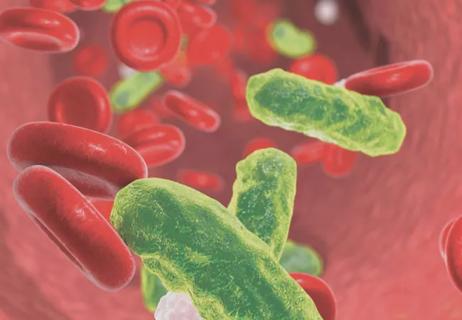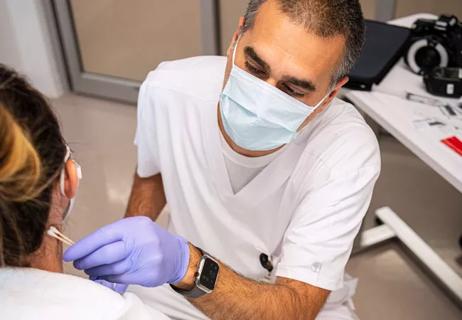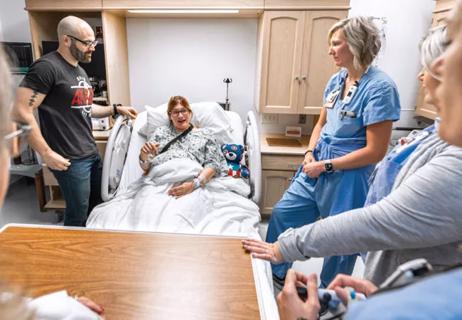Nurses educate staff throughout the hospital on benefits

Approximately 24,000 fetal deaths over 20 weeks gestation occur in the United States each year, according to the Centers for Disease Control and Prevention. In addition, about 10 percent of clinically recognized pregnancies end in miscarriage, according to The American College of Obstetricians and Gynecologists. Parents who lose babies during pregnancy – whether early or late – often suffer a profound sense of grief at a time when they anticipate such joy. In the past couple years, a team of nurses from the Birthing Center at Cleveland Clinic Fairview Hospital have revamped their perinatal bereavement program to help these parents cope.
Cleveland Clinic is a non-profit academic medical center. Advertising on our site helps support our mission. We do not endorse non-Cleveland Clinic products or services. Policy
Kathy Ballantine, RN, a staff nurse in Fairview’s Birthing Center led the charge to expand the hospital’s perinatal bereavement program in 2014. She and five other nurses are members of the Birthing Center Families Experiencing Early Loss (F.E.E.L.) Committee that facilitates the program and spreads the message about the importance of perinatal bereavement services.
Two years ago, committee members attended a week-long conference on perinatal loss hosted by Resolve Through Sharing, a non-profit organization that offers training on bereavement care. “All of us had the desire and compassion to help patients, but the conference helped us with how to deal with grieving patients,” says Ballantine. The biggest takeaway from the conference was the need to educate other departments at Fairview Hospital. The nurses realized that patients coming to the emergency department with miscarriages weren’t getting the same level of emotional support as women experiencing later pregnancy loss in the Birthing Center.
“How the healthcare staff cares for and communicates with families experiencing loss greatly influences how they leave the hospital setting and enter the long process of adapting to a new life without a child,” Ballantine explains. She and her colleagues now provide training and education on the hospital’s F.E.E.L. program to the emergency department, surgery centers and obstetricians. This year, Ballantine spoke to residents at Cleveland Clinic’s main campus. “This was such a milestone, and we are seeing the benefits,” she says.
But educating fellow healthcare providers is harder than you might think. “Even some people in the medical field don’t get why this is significant,” she says. “The baby hasn’t been born, so why do people need help? Those patients are often left grieving with no support, even from families.” One of the ways Ballantine impresses upon hospital staff that perinatal loss can be devastating is by displaying models of a fetus at various stages of development, such as 12 weeks and 20 weeks. That grabs their attention, then Ballantine talks about the services offered by F.E.E.L.
When patients who experience a fetal death are admitted to the Birthing Center, the unit tries to team an experienced nurse with a newer nurse. If possible, nurses who tend to these patients are not assigned other laboring moms because transitioning from a room with a distraught family to one filled with joy is very difficult.
F.E.E.L. has a two-tiered program, depending on whether the pregnancy loss is early or late:
Every action is designed to make the baby special and allow the family to feel connected to their baby. The nurses provide families an outlet to grieve, which is often cathartic for them. Ballantine recalls a father who lost twin daughters late in the pregnancy. “He asked if he could dance with them because he always pictured dancing with them at their weddings,” she says. The nurses played gentle music in the room for the father-daughter dances.
“It’s amazing the transformation in patients when they know it’s OK to grieve these babies,” says Ballantine.
For many women, the monthly support group led by Ballantine is the most helpful part of F.E.E.L. During the unstructured hour-and-a-half session, families who have lost children share their feelings. They talk about everything from how to answer questions about how many children you have to what to say to extended family members who aren’t supportive. “They want to know they are not crazy for grieving this baby and that there are other people who have been through it and made it to the other side,” says Ballantine.
All of the aspects of F.E.E.L. – from care of the patient when they first learn their baby has died to an annual memorial service for the babies held every October – are designed to ease the pain of mourning families. “Perinatal loss is a much discounted loss in society,” says Ballantine. “These families deserve our support.”

Nurses play pivotal role in patients’ ability to recover in the comfort of their own homes

Advocating for patient safety is imperative in fast-paced surgical settings

Advice for those pursuing a WOC nursing career

Redesigned protocols enhance infection-prevention measures

Longevity in healthcare, personal experiences may provide caregivers with false sense of confidence

Specialized team prioritizes trauma-informed care and evidence collection

Collaborative approach leans on expertise of nurses

TeamBirth aims to improve outcomes by facilitating collaboration between patients and caregivers